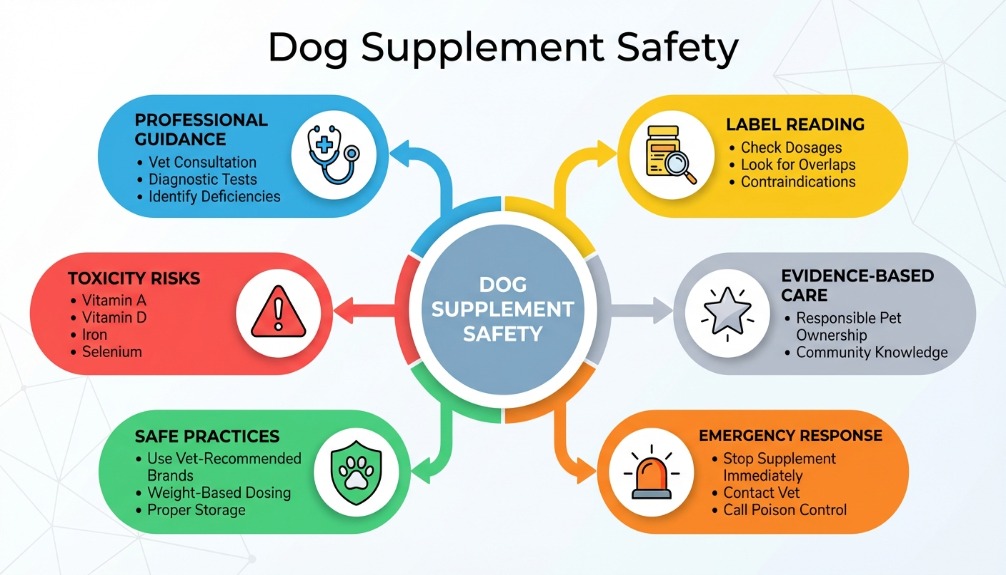The Best Fluffy Pancakes recipe you will fall in love with. Full of tips and tricks to help you make the best pancakes.

Balance your dog’s vitamins and minerals with 3 key tips—avoid deficiencies, excess, and costly health mistakes. Like a ship’s navigator scanning the stars, you need clear markers to keep your dog’s nutrition on course. Start with a simple health checklist — coat, energy, stool, weight — and use it to spot gaps tied to life stage or medical needs. Then match supplements to specific problems, avoid mega-doses, and reassess every 3–6 months to prevent harm and refine what really helps.
Key Takeaways
- Use a monthly health checklist (body score, coat, stool, energy, infections) to spot nutrient gaps like protein, omega‑3s, calcium, and vitamin D.
- Base supplementation on life stage, activity, and veterinary diagnosis, not on marketing or perceived needs alone.
- Always consult your veterinarian and run tests before adding vitamins/minerals to avoid deficiencies or toxicities.
- Read labels for dosages, overlapping ingredients, and contraindications; prefer single‑purpose, evidence‑backed supplements.
- Reassess supplements every 3–6 months, document changes, and share records with your clinic for tailored adjustments.
Spot Nutrient Gaps With a Simple Health Checklist

Want a quick way to spot where your dog’s diet might be falling short? Use a concise health checklist you can run through monthly: body condition score, coat and skin quality, stool consistency, energy levels, and any recurring infections. That checklist helps you spotlight essential nutrients like protein, omega-3s, calcium, and vitamin D a shiny coat rules out fatty acid needs or skipping fecal checks — can spot correlations. If you notice weight loss, dull hair, or frequent limpness, flag those for immediate review. This practical, evidence-based routine brings you into a community of attentive owners: you’re not overreacting, you’re monitoring thoughtfully. Regular, simple checks let you prevent small gaps from becoming bigger problems.
Choose Supplements Based on Life Stage and Medical Needs
Now that you’ve got a monthly checklist to spot nutrient gaps, use those findings to guide which supplements your dog actually needs. You’ll choose life stage supplements that match growth, adult maintenance, or senior support, and you’ll assess medical needs with veterinary guidelines before adding anything. Base choices on weight, activity, and diagnoses like joint disease, kidney issues, or allergies.
Use your checklist to guide life-stage and condition-specific supplements, working with your vet to tailor dosing and reassess regularly.
- Ask your vet for tests and dosing recommendations so you can tailor omega-3s, glucosamine, or vitamins safely.
- Prioritize single-purpose supplements backed
- Reassess every 3–6 months and adjust as your dog’s life stage or health changes, keeping records you can share with your clinic.
You’re part of a community of caregivers; collaborate with your vet, trust evidence-based products, and make adjustments that keep your dog thriving through each life stage.
Dog Supplement Safety: Prevent Vitamin Toxicity in Dogs

Giving your dog supplements can feel like an act of love—but without the right guidance, it may cause more harm than good. To ensure dog supplement safety and avoid dog supplement mistakes or dog vitamin overdose symptoms, follow these practical steps. This guide also serves as a quick dog health supplements guide for responsible pet owners and highlights pet supplement safety best practices.
1. Seek Professional Guidance
Always consult your veterinarian before adding vitamins or minerals. A vet can run tests and review your dog’s health history to identify real deficiencies or risks. This ensures you’re choosing safe vitamins for dogs and not exposing them to unnecessary dangers. Professional advice is the foundation of pet supplement safety.
2. Read Labels Carefully
Check dosages, ingredient overlaps, and contraindications. Many products combine multiple nutrients, which can lead to accidental overdosing if you’re not careful. Proper label reading helps you prevent supplement overdose in pets and avoid costly dog supplement mistakes.
3. Recognize Toxicity Risks
Some nutrients are safe in small amounts but harmful in excess. Common dangers include:
- Vitamin A toxicity → vomiting, lethargy, appetite loss
- Vitamin D toxicity → kidney issues
- Excess iron → gastrointestinal upset
- Selenium imbalance → weakness, digestive problems
Knowing these dog vitamin overdose symptoms helps you act quickly and protect your pet’s health.
4. Practice Safe Supplementation
- Stick to veterinary-recommended brands
- Calculate doses based on your dog’s weight
- Avoid human supplements unless your vet approves
- Store products safely to prevent accidental overdoses
These steps ensure safe supplements for dogs and strengthen overall pet supplement safety.
5. Respond Quickly to Problems
If you notice adverse effects, stop the supplement immediately and contact your vet or a poison control center. Fast action can save your dog from serious harm.
Why This Matters
nd join a community that values evidence-based pet care. Thoughtful supplementation isn’t just about adding nutrients—it’s about keeping your best friend safe. This dog health supplements guide empowers you to make informed, responsible choices.
Frequently Asked Questions
Can Puppies Get Too Many Vitamins From Mother’s Milk While Nursing?
Absolutely — not usually: puppy vitamin levels in mother’s milk are naturally balanced, so you won’t overload them while nursing, but there are exceptions. If the dam’s diet’s supplemented excessively or she’s ill, certain nutrients (like vitamin A or D) can reach risky levels. Check milk safety with your vet, avoid extra supplements for nursing mothers unless directed, and you’ll keep the litter healthy and feeling supported.
Are Natural Food Sources Always Safer Than Supplements for Dogs?
No — natural sources aren’t always safer than supplements for dogs. You’ll often get balanced nutrients from whole foods, but contamination, incorrect doses, or toxic ingredients can occur. Assess natural sources and supplement safety ’ll feel more confident when you combine reliable whole foods with vetted supplements only as needed, monitored
How Do Breed-Specific Needs Affect Vitamin and Mineral Requirements?
Yes — breed specific needs change vitamin mineral balance because size, growth rate, genetic predispositions and activity influence requirements. You’ll tailor intake for giant breeds, toy dogs, working lines or breeds prone to joint or metabolic problems. Work with your vet to test levels, adjust diet or add targeted supplements, and monitor weight and energy. You’ll feel reassured knowing choices match your dog’s breed-specific risks and life stage.
Can Supplements Interfere With Medications My Dog Is Taking?
Yes — supplements can interfere with your dog’s meds. Think of supplements as guests at a dinner: some sit politely, others rearrange the table. Mineral supplements and herbal products often cause supplement interactions or change drug absorption, so you’ll need careful medication timing and vet guidance. Share all supplements you’re using, ask about safe intervals, and stick to evidence-based doses so your dog stays healthy and you feel supported.
Should I Rotate Different Supplement Brands for Variety?
Yes — you can rotate supplement brands, but prioritize consistency in core nutrients while balancing variety vs consistency. Rotating offers brand diversification benefits like reduced exposure to single-source contaminants and access to slightly different formulations, yet you should keep nutrient profiles stable to avoid imbalances. Talk with your vet, track outcomes, and switch slowly. You’ll feel more confident knowing you’re combining thoughtful variety with evidence-based consistency for your dog’s health.
Why Dog Supplements Matter
Your dog’s health depends not only on daily food but also on how well their nutritional needs are met. Studies show that up to 60% of pet owners give supplements without veterinary guidance, which increases the risk of toxicity, overdosing, or nutrient imbalance.
When chosen wisely, dog supplements in Athens, Lamia, and across Greece can support joint health, skin and coat condition, digestion, immunity, weight management, and even cognitive function. They should always complement a balanced diet for dogs, not replace it, and must be tailored to your dog’s life stage, breed, size, and health condition.
Key Health Signals to Watch
Many owners ask: How do I know if my dog needs supplements? Look for everyday signs such as:
- Coat & Skin: dull fur, excessive shedding, or itchy skin may point to deficiencies in omega‑3 fatty acids, zinc, or vitamins A and E.
- Energy Levels: fatigue, lethargy, or unusual hyperactivity can signal imbalanced nutrition or hidden deficiencies.
- Stools & Digestion: changes in texture, frequency, or color may indicate digestive problems, poor nutrient absorption, or food intolerances.
- Mobility: stiffness, limping, or reluctance to exercise may suggest a need for joint supplements for dogs (glucosamine, chondroitin, MSM).
- Weight changes: sudden gain or loss can highlight dietary imbalance or endocrine issues.
Keeping a checklist of these signals and sharing it with your veterinarian in Athens, Lamia, or your local area helps identify nutritional gaps early and prevents unnecessary or harmful supplementation.
Choosing the Right Supplements
Pet owners often wonder: Which supplements are safe and effective for dogs? The answer depends on context:
- Life-stage priorities: puppies need growth nutrients (calcium, DHA), adults need maintenance, and seniors may benefit from joint, heart, or cognitive support.
- Targeted products: choose single-purpose, vet-approved supplements near you (e.g., probiotics for dogs for gut health, omega‑3 for skin and joints, antioxidants for immunity, digestive enzymes for absorption).
- Natural dog supplements in Greece: herbal blends and plant-based options can be useful, but only when backed
- Reassess every 3–6 months: your dog’s needs shift with age, weight, activity level, and health status.
What to Avoid
Another common question is: Are human vitamins safe for dogs? The answer is no. Many human supplements contain toxic ingredients such as xylitol, iron, or alpha-lipoic acid. Other risks include:
- Mega-doses: excessive vitamins (A, D, E) or minerals (iron, calcium) can cause toxicity.
- Trendy “miracle” powders: unregulated blends may lack evidence and carry hidden risks.
- Skipping the vet: professional guidance is essential for safe and effective use.
Expanding the Options: Beyond Basics
Modern veterinary nutrition highlights several supplement categories with proven benefits:
- Probiotics & prebiotics → support gut microbiome balance and digestion.
- Omega‑3 fatty acids (EPA/DHA) → reduce inflammation, improve skin and coat, and support heart health.
- Glucosamine & chondroitin → protect cartilage and ease joint stiffness.
- Antioxidants (vitamin C, E, coenzyme Q10) → protect cells from oxidative stress.
- Digestive enzymes → help dogs with sensitive stomachs or absorption issues.
- Multivitamins → fill specific nutrient gaps when diet alone is insufficient.
Many of these products are available through local pet shops in Athens, Lamia, and Central Greece, or directly from veterinary clinics offering nutrition consultations.
Conclusion
Dog supplements in Greece can truly enhance your dog’s health when used wisely, moderately, and under veterinary supervision. They are not a shortcut or replacement for a balanced diet for dogs, but they can fill important gaps and support long-term wellness.
If you notice changes in your dog’s coat, energy, digestion, mobility, or weight, don’t guess. Work with your local veterinarian in Athens, Lamia, or your region, choose evidence-based, vet-approved supplements, and review your dog’s nutrition plan regularly. That way, every capsule, chew, or powder you give will actually help—not harm—your best friend.









